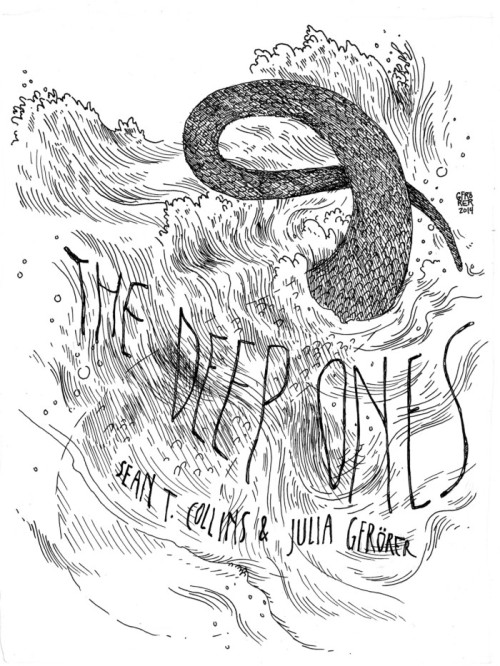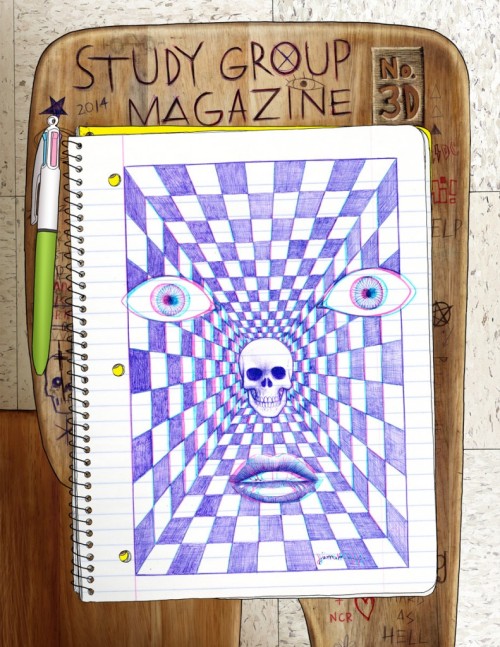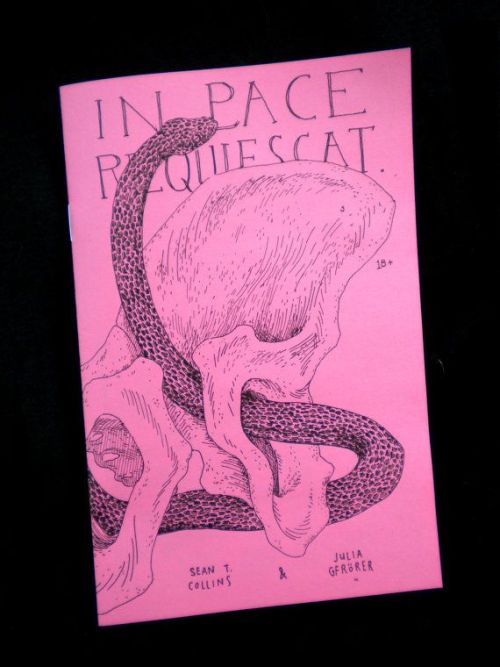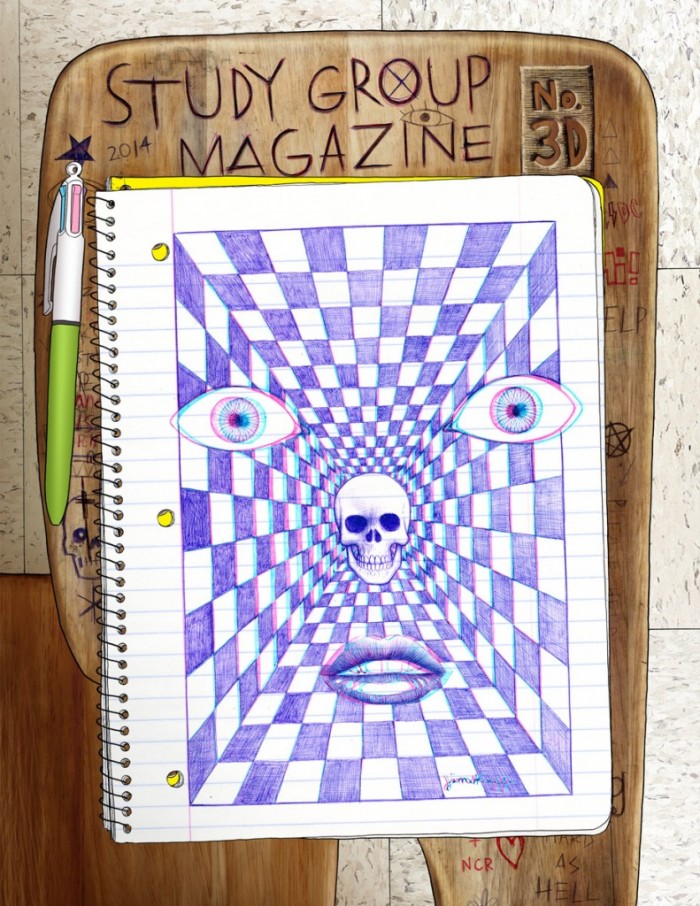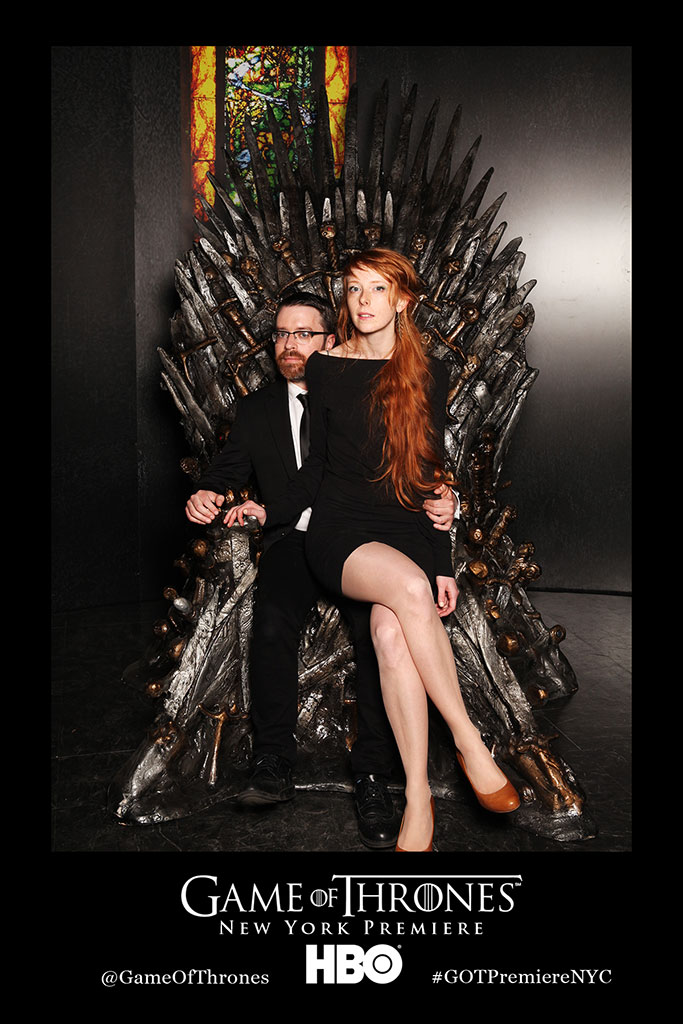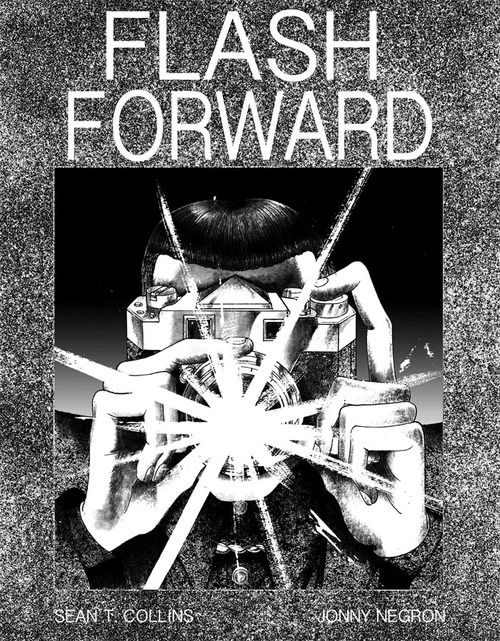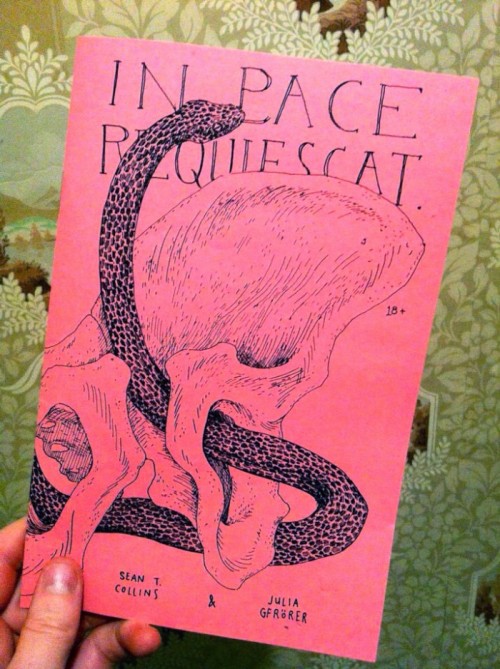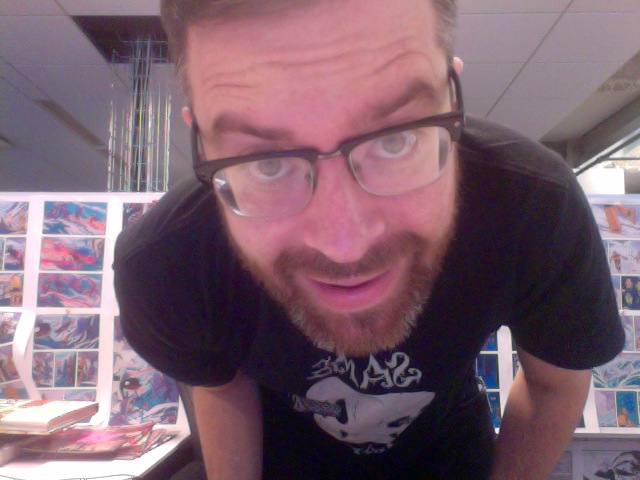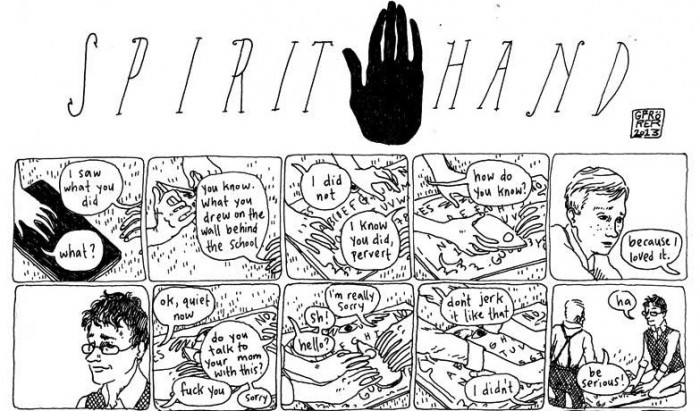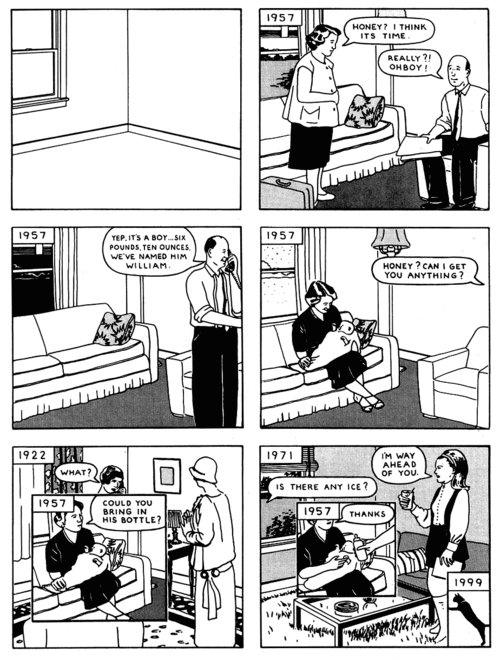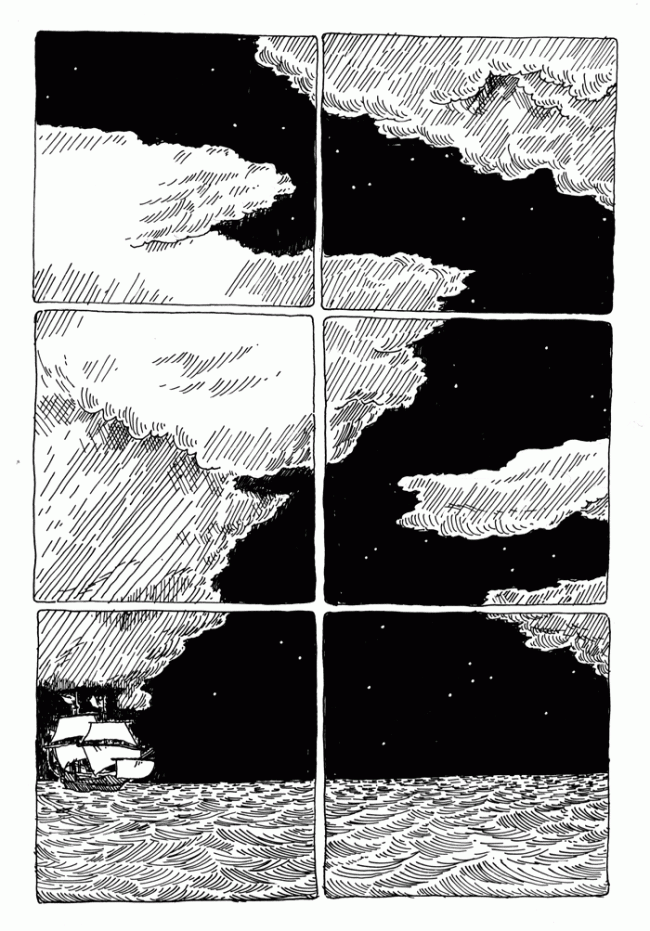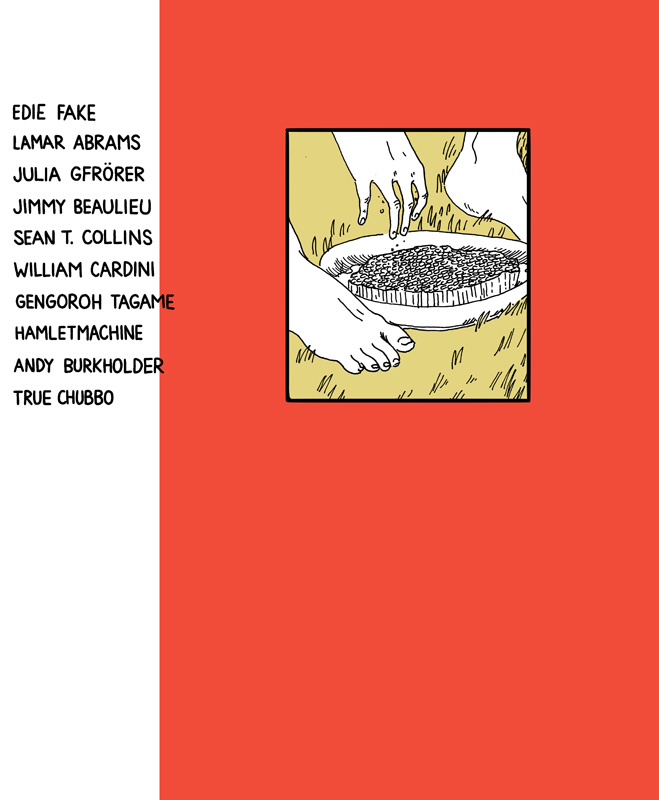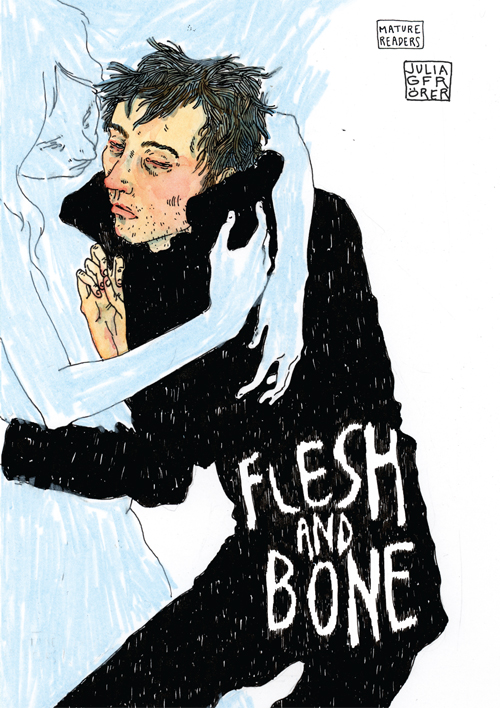Posts Tagged ‘Julia Gfrörer’
The Deep Ones
October 27, 2014by Sean T. Collins & Julia Gfrörer
Julia and I made a comic about sea monsters, their meaning, and their menace. You can read it at The Nib and buy it in “Deep Trouble,” the latest issue of Symbolia Magazine.
You can also follow the inspiration blog we made for the comic, the-deep-ones.
STC @ SPX
September 9, 2014I’m going to be at SPX, the Small Press Expo, in Bethesda, Maryland this weekend. I look like the person in the photo up top. I’m going to have work in the new Study Group Magazine #3D, which will debut at the show; I wrote a brand-new four-page comic about werewolves and secrets called “Hiders” that was drawn by Julia Gfrörer. Julia will also be selling our comic In Pace Requiescat, a pornographic extrapolation from “The Cask of Amontillado” by Edgar Allan Poe; I should have copies of Flash Forward, the horror comic Jonny Negron and I made about seeing and being seen, as well. I suspect you’ll find me mostly at Julia’s table, W34B. We look like the people in the photo at the bottom. SPX is a terrific show, and if you’re anywhere in the DC/Baltimore area and have any interest in alternative comics at all it’s well worth the trip. I would love to see you there!
STC @ CAKE
May 29, 2014Come see me at CAKE, the Chicago Alternative Comics Expo (the “k” is silent, and invisible), this weekend! I’ll sporadically be at table 68A with Julia Gfrörer, hawking our Edgar Allan Poe porn comic In Pace Requiescat and potentially Flash Forward by me and Jonny Negron too, and I look like this.
Sean & Julia on Poe & Porn
May 5, 2014What inspired you to make this Poe Porn (lol)?
Sean: Julia and I have a lot in common, and one of those things happened to be a fascination with this particular Poe story, which we’d both read at an impressionable age.
Julia: I felt like Sean’s script was such an effective interpolation of the original story because in a sense it wasn’t radical at all, its constituent elements are entirely native to the source material. There are hints of regret, of reluctance, almost tenderness, supporting the maniacal sadism. The meticulousness with which Montresor inflicts the final act of cruelty on his friend already carries an erotic undertone–maybe not all readers experience that, but Sean and I didn’t invent it.
Sean: In “The Cask of Amontillado” I recognized a link between the genres of horror and pornography. Both frequently rely on a sense of certainty for their visceral emotional impact: When you begin to read or watch a horror story, you know that a terrible thing will happen, and frequently so does the character to whom it’s going to happen. In pornography, as in sex generally, you know that when your partner begins touching you, you have entered into a process that will end with you briefly losing control of your own body, unable to think of anything but the pleasure your partner is effectively forcing you to experience at the expense of everything else. In both cases that certainty is magnetic to minds trapped in our unforgivingly inconstant and unpredictable world. Dread and eroticism are two sides of the same coin neither of us can stop flipping in the art we make or consume.
Julia: Right, I rarely respond to a sex scene that doesn’t have some foreboding attached to it. The sense that the world has stopped and what’s happening right now is the only thing that matters or exists is romantic, but it also feels like something on the verge of panic.
Sean: “The Cask of Amontillado” and Montresor’s revenge scheme both depend on that certainty — on Montresor letting Fortunato know exactly what’s happening to him, and exactly what will continue to happen to him until he dies. There just came a day when I wondered what would happen if Montresor’s mental circuit overloaded and that horrific mastery over another human being became erotic mastery over the same person. This was the result.
We hope to do more Poe-nography together, actually. We’ve been talking about “The Fall of the House of Usher.”
Julia: “The Pit and the Pendulum” seemed a little on the nose.
—Glory Hole In One: A NSFW Comic Book Review & Interview | Slutist
The marvelous writer/musician/dominatrix Hether Fortune interviewed me and Julia Gfrörer about In Pace Requiescat, our pornographic adaptation of/extrapolation from “The Cask of Amontillado” by Edgar Allan Poe, for Slutist.You can buy the comic here.
Study Group Magazine #3D
April 21, 2014Power couple
March 21, 2014STC at CAB
November 8, 2013I will be attending tomorrow’s Comic Arts Brooklyn festival at Brooklyn’s Mt. Carmel Church. There I’ll be debuting two books that I wrote: Flash Forward, drawn by Jonny Negron, and In Pace Requiescat, drawn by Julia Gfrörer and inspired by “The Cask of Amontillado” by Edgar Allan Poe. I don’t have a table per se, but I imagine I will spend some time selling In Pace Requiescat at table D18 and selling Flash Forward at (I think?) tables U8/U9 or wherever else Jonny winds up. You will likely also find me loitering with my Destructor compatriot Matt Wiegle at table D34 as well. If you’re looking for me, I look like this, so please say hello!
New comic
October 30, 2013Julia Gfrörer and I will be debuting a new comic at CAB. This is a preview image for it.
Comics Time: “Spirit Hand” and “Here”
July 3, 2013Comics Time: Black Is the Color
March 21, 2013Thickness #3: Back cover, bed of contents
June 6, 2012THICKNESS #3
30XX by Lamar Abrams
PROTESTPLOITATION by Jimmy Beaulieu
NIGHTCRAWLERS by Edie Fake
THE CHASM by Julia Gfrörer
THE COCKROACH by William Cardini & Sean T. Collins
STANDING OVATIONS by Gengoroh Tagame
QVIET by Andy Burkholder
…and a pinup by HamletMachine
(via Ryan Sands)
Love Me Like a Reptile/Feel My Serpentine
June 1, 2012Behold Edie Fake’s cover for Thickness #3, the erotic comics anthology featuring Edie Fake, Lamar Abrams, Julia Gfrörer, Jimmy Beaulieau, Sean T. Collins (yep, me!), William Cardini (who drew the thing I wrote), Gengoroh Tagame, Hamletmachine, Andy Burkholder, and True Chubbo, edited by Ryan Sands and Michael DeForge. Debuts at CAKE on June 16, available online everywhere shortly thereafter.
The 20 Best Comics of 2011
January 1, 201220. Uncanny X-Force (Rick Remender and Jerome Opeña, Marvel): In a year when the ugliness of the superhero comics business became harder than ever to ignore, it’s fitting that the best superhero comic is about the ugliness of being a superhero. Remender uses the inherent excess of the X-men’s most extreme team to tell a tale of how solving problems through violence in fact solves nothing at all. (It has this in common with most of the best superhero comics of the past decade: Morrison/Quitely/etc. New X-Men, Bendis/Maleev Daredevil, Brubaker/Epting/etc. Captain America, Mignola/Arcudi/Fegredo/Davis Hellboy/BPRD, Kirkman/Walker/Ottley Invincible, Lewis/Leon The Winter Men…) Opeña’s Euro-cosmic art and Dean White’s twilit color palette (the great unifier for fill-in artists on the title) could handle Remender’s apocalyptic continuity mining easily, but it was in silent reflection on the weight of all this death that they were truly uncanny.
19. The League of Extraordinary Gentlemen Vol. 3: Century #2: 1969 (Alan Moore and Kevin O’Neill, Top Shelf/Knockabout): I’ll admit I’m somewhat surprised to be listing this here; I’ve always enjoyed this last surviving outpost of Moore’s comics career but never thought I loved it. But in this installment, Moore and O’Neill’s intrepid heroes — who’ve previously overcome Professor Moriarty, Fu Manchu, and the Martian war machine — finally succumb to their own excesses and jealousies in Swinging London, allowing a sneering occult villain to tear them apart with almost casual ease. It’s nasty, ugly, and sad, and it’s sticking with me like Moore’s best work.
18. The comics of Lisa Hanawalt (various publishers): As I put it when I saw her drawing of some kind of tree-dwelling primate wearing a multicolored hat made of three human skulls stacked on top of one another, Lisa Hanawalt has a strange imagination. And it’s a totally unpredictable one, which is what makes her comics – whether they’re reasonably straightforward movie lampoons or the extravagantly bizarre sex comic she contributed to Michael DeForge and Ryan Sands’s Thickness anthology, as dark and damp as the soil in which its earthworm ingénue must live – a highlight of any given day a new one pops up.
17. Daybreak (Brian Ralph, Drawn and Quarterly): Fort Thunder’s single most accessible offspring also proves to be its bleakest, thanks to an extended collected edition that converts a rollicking first-person zombie/post-apocalypse thriller into a troubling meditation on the power of the gaze. Future artcomics takes on this subgenre have a high bar to clear.
16. Habibi (Craig Thompson, Pantheon): It’s undermined by its central characters, who exist mainly as a hanger on which this violent, erotic, conflicted, curious, complex, endlessly inventive coat of many colors is hung. But as a pure riot of creative energy from an artist unafraid to wrestle with his demons even if the demons end up winning in the end, Habibi lives up to its ambitions as a personal epic. You could dive into its shifting sands and come up with something different every time.
15. Ganges #4 (Kevin Huizenga, Coconino/Fantagraphics): Huizenga wrings a second great book out of his everyman character’s insomnia. It’s quite simple how, really: He makes comics about things you’d never thought comics could be about, by doing things you never thought comics could do to show you them. Best of all, there’s still the sense that his best work is ahead of him, waiting like dawn in the distance.
14. The Congress of the Animals (Jim Woodring, Fantagraphics): The potential for change explored by the hapless Manhog in last year’s Weathercraft is actualized by the meandering mischief-maker Frank this time around. While I didn’t quite connect with Frank’s travails as deeply as I did with Manhog’s, the payoff still feels like a weight has been lifted from Woodring’s strange world, while the route he takes to get there is illustrated so beautifully it’s almost superhuman. It’s the happy ending he’s spent most of his career earning.
13. Mister Wonderful (Daniel Clowes, Pantheon): Speaking of happy endings an altcomix luminary has spent most of his career earning! Clowes’s contribution to the late, largely unlamented Funny Pages section of The New York Times Magazine is briefly expanded and thoroughly improved in this collected edition. Clowes reformats the broadsheet pages into landscape strips, eases off the punchlines and cliffhangers, blows individual images up to heretofore unseen scales, and walks us through a self-sabotaging doofus’s shitty night into a brighter tomorrow.
12. The comics of Gabrielle Bell (various publishers): Bell is mastering the autobiography genre; her deadpan character designs and body language make everything she says so easy to buy – not that that would be a challenge with comics as insightful as her journey into nerd culture’s beating heart, San Diego Diary, just by way of a for instance. But she’s also reinventing the autobiography genre, by sliding seamlessly into fictionalized distortions of it; her black-strewn images give a somber, thoughtful weight to any flight of fancy she throws at us. What a performance, all year long.
11. The Armed Garden and Other Stories (David B., Fantagraphics): Religious fundamentalism is a dreary, oppressive constant in its ability to bend sexuality to mania and hammer lives into weapons devoted to killing. But it has worn a thousand faces in a millennia-long carnevale procession of war and weirdness, and David B. paints portraits of three of its masks with bloody brilliance. Focusing on long-forgotten heresies and treating the most outlandish legends about them as fact, B.’s high-contrast linework sets them all alight with their own incandescent madness.
10. Too Dark to See (Julia Gfrörer, Thuban Press): It was a dark year for comics, at least for the comics that moved me the most. And no one harnessed that darkness to relatable, emotional effect better than Julia Gfrörer. Her very contemporary take on the legend of the succubus was frank and explicit in its treatment of sexuality, rigorously well-observed in its cataloguing of the spirit-sapping modern-day indignities that can feed depression and destroy relationships, and delicately, almost tenderly drawn. It’s like she held her finger to the air, sensed all the things that can make life rotten, and cast them onto the pages. She made something quite beautiful out of all that ugly.
9. The comics and pixel art of Uno Moralez (self-published on the web at unomoralez.com): What if an 8-bit NES cut-scene could kill? The digital artwork of Uno Moralez — some of it standard illustrations, some of it animated gifs, some of it full-fledged comics — shares its aesthetic with The Ring‘s videotape or Al Columbia’s Pim & Francie: a horror so cosmically black, images so unbearably wrong, that they appear to have leaked into and corrupted their very medium of transmission. Moralez fuses crosses the streams of supernatural trash from a variety of cultures — the legends and Soviet art of his native Russia, the horror and porn manga of Japan, the B-movies and horror stories of the States, the formless sensation aesthetic of the Internet itself — into a series of images that is impossible to predict in its weirdness but totally unflagging in its sense that you’d be better off if you’d never laid eyes on it. I can’t wait to see more.
8. The comics of Michael DeForge (various publishers): The last time you saw a cartoonist this good and this unique this young, you were probably reading the UT Austin student newspaper comics section and stumbling across a guy named Chris Ware. All four of DeForge’s best-ever comics — his divorced dad story in Lose #3, his shape-shifting/gender-bending erotica in Thickness #2, his self-published art-world fantasia Open Country, and his gorgeously colored body-horror webcomic Ant Comic — came out this year, none of them looking anything at all like anything you could picture before seeing your first Michael DeForge comic. It’s almost frightening to think where he’ll be five years from now, ten years from now…or even just this time next year.
7. The comics and art of Jonny Negron (various publishers): What if someone took Christina Hendricks’s walk across the parking lot and trip to the bathroom in Drive and made an entire comics career out of them? That is an enormously facile and reductive way to describe the disturbing, stylish, sexy, singular work of Jonny Negron, the breakout cartoonist of the year, but it at least points you in the right direction. No one’s ever thought to combine his muscular yet curiously dispassionate bullet-time approach to action and violence, his Yokoyama-esque spatial geometry, his attention to retrofuturistic fashion and style, his obvious love of the female body in all its shapes and sizes, and his ambient Lynchian terror; even if they had, it’d be tough to conceive of anyone building up his remarkable body of work in such a short period of time. Open up your Tumblr dashboard or crack an anthology (Thickness, Mould Map, Study Group, Smoke Signal, Negron and Jesse Balmer’s own Chameleon), and chances are good that Negron was the weirdest, best, most coldly beautiful thing in it. It’s like a raw, pure transmission from a fascinating brain.
6. The Wolf (Tom Neely, I Will Destroy You): Neely’s wordless, painted, at-times pornographic graphic novel feels like the successful final draft to various other prestigious projects’ false starts. It’s a far less didactic, more genuinely erotic attempt at high-art smut than Dave McKean’s Celluloid; a less self-conscious, more direct attempt at frankly depicting both the destructive and creative effects of sex on a relationship via symbolism than Craig Thompson’s Habibi; a blend of sex and horror and narrative and visual poetry and ugly shit and a happy ending that succeeds in each of these things where many comics choose to focus on only one or two.
5. The Cardboard Valise (Ben Katchor, Pantheon): Prep your time capsules, folks: You’d be hard pressed to find an artifact that better conveys our national predicament than Ben Katchor’s latest comic-strip collection, a series of intertwined vignettes created largely before the Great Recession and our political class’s utter failure to adequately address it, but which nonetheless appears to anticipate it. Its message — that blind nationalism is the prestige of the magic trick used by hucksters to financially and culturally ruin societies for their own profit — is delightfully easy to miss amid Katchor’s remarkable depictions of lost fads, trends, jobs, tourist attractions, and other detritus of the dying American Century. He’s the very most funnest Cassandra around.
4. Love from the Shadows (Gilbert Hernandez, Fantagraphics): I picture Gilbert Hernandez approaching his drawing board these days like Lawrence of Arabia approaching a Turkish convoy: “NO PRISONERS! NO PRISONERS!” In a year suffused with comics funneling pitch-black darkness through a combination of sex and horror, none were blacker, sexier, or more horrific than this gender-bending exploitation flick from Beto’s “Fritz-verse.” None also functioned as a rejection of the work that made its creator famous like this one did, either. Not a crowd-pleaser like his brother, but every bit as brilliant, every bit as fearless.
3. Garden (Yuichi Yokoyama, PictureBox): Like a theme park ride in comics form — with the strange events it chronicles themselves resembling a theme park ride — Yokoyama’s book is a breathtaking, breathless experience. Alongside his anonymous but extravagantly costumed non-characters, we simply go along for the ride, exploring Yokoyama’s prodigious, mysterious imagination as he concocts a seemingly endless stream of increasingly strange interfaces between man and machine, nature and artifice. As a metaphor for our increasingly out-of-control modern life it’s tough to top. As pure thrilling kinetic cartooning it’s equally tough to top.
2. Big Questions (Anders Nilsen, Drawn & Quarterly): Last year, I wrote that if the collected edition of Nilsen’s long-running parable of philosophically minded birds and the plane crash that turns their lives upside-down didn’t top my list whenever it came out, it must have been some kind of miracle year. Turns out that it was. But you’d pretty much have to create a flawless capstone to a thirty-year storyline of neer-peerless intelligence and artistry to top this colossal achievement. Nilsen’s painstaking, pointillist cartooning and ruthless examination of just how little regard the workings of the world have for any given life, human or otherwise, marks him as the best comics artist of his generation, and solidifies Big Questions‘ claim as the finest “funny animal” comic since Maus.
1. Love and Rockets: New Stories #4 (Gilbert and Jaime Hernandez, Fantagraphics): Gilbert got his due elsewhere on my list, so let’s ignore his contribution to this issue, which advance the saga of his bosomy, frequently abused protagonist Fritz Martinez both on and off the sleazy silver screen. Instead, let’s add to the chorus praising Jaime’s “The Love Bunglers” as one of the greatest comics of all time, the point toward which one of the greatest comics series of all time has been hurtling for thirty years. In a single two-page spread Jaime nearly crushes both his lovable, walking-disaster main characters Maggie and Ray with the accumulated weight of all their decades of life, before emerging from beneath it like Spider-Man pushing up from out of that Ditko machinery. You can count the number of cartoonists able to wed style to substance, form to function, this seamlessly on one hand with fingers to spare. A masterpiece.
Comics Time: Flesh and Bone
November 17, 2011Flesh and Bone
Julia Gfrörer, writer/artist
Sparkplug, 2010
40 pages
$6
Buy it from Sparkplug
Death as an irreparable rupture. Explicit, raw, wounded-animal sexuality. The calculating and casual torture and murder of children. Occult evil that actively belittles the human capacity for love and kindness. It’s tough to think of a darker brew than the one Julia Gfrörer serves in Flesh and Bone, the all too aptly titled tale of a man who’ll do anything to be reunited with his dead beloved and the witch who’s all too happy to accommodate him. But it’s a heady brew, too. Gfrörer’s intelligence shines through in virtually every particular, from pacing (the excruciatingly interminable sequence in which the bereaved man writhes first in agony then in resigned masturbatory ecstasy on his beloved’s grave) to dialogue (a devastating exchange between witch and demon in which love is dismissed as “mutual masturbation,” a form of slavery that prevents humankind from pulling itself out of the muck) to strategic absences of dialogue (a harrowing silent sequence in which an owl is sent to blind a young witness to a horrible crime) to character design (the man’s Byronic good looks, the demon’s disembodied lion head) to facial expression and body language (the witch’s arched back and closed lids as she copulates with a screeching mandrake creature) to a cover that nails the appeal of her wiry, frail characters and line. I can think of few efforts in this vein that impress me, or resonate with me, more deeply than Gfrörer’s. Highly recommended.
Comics Time: Too Dark to See
June 3, 2011Too Dark to See
Julia Gfrörer, writer/artist
Thuban Press, May 2011
32 pages
$5
Buy it from Julia Gfrörer
Buy it from Sparkplug
“I just need your cum. Give it to me and I’ll go away.” Well, hello, sailor! In the vanguard of a burgeoning mini-movement of alternative comics dealing frankly and explicitly with/in sex, Too Dark to See centers on a liaison between a sleepy (or possibly sleeping) young man and a spectral shadow woman, the bluntly transactional nature of which is no doubt hot to some, cold to others. It’s tough to figure out how to feel about it, actually, and that’s what makes it a fine catalyst for the story, which is primarily about the real live human couple of which the guy is a part. His girlfriend, our protagonist through the bulk of the story, is introduced to us as either she or he (it’s not clear who; I’m not sure it matters) says “No one has ever loved anyone more than I love you” as they embrace in bed, but before long she’s being cuckolded by a shadow creature. We next see her sitting on the toilet, naked from the waist down, awkwardly asking the guy if he remembers jerking off in his sleep. She’s at a disadvantage throughout: She thinks her boyfriend might be cheating on her and her suspicion is greeted with angry dismissal, she fails to pick up on cues he thinks are screamingly obvious and interrupts him as he works on writing “the first good idea I’ve had in ages,” she suspects a customer at the coffee shop where she works of coming in solely to judge her, she’s worried about a black spot that could be an STD but which we can gather from our experience with the shadow person is likely something far more sinister, she self-mutilates, she struggles to even be heard at one point while lying under the covers when her boyfriend returns after storming off, and even supernatural entities make fun of her. Factor in Gfrörer’s shaky, wiry line, really perfect for capturing both the undermployed bohemian demimonde and the veal-calf physicality of young skinny naked people, and the feeling that emerges is one of almost overwhelming vulnerability — a woman who feels at the mercy of love, sex, money, class, and her own body, to the point where the addition of dark forces from beyond feels not just appropriate but almost inevitable. It’s an ugly feeling, and it takes a special sort of beauty to capture it as well as this disarming little comic does.

